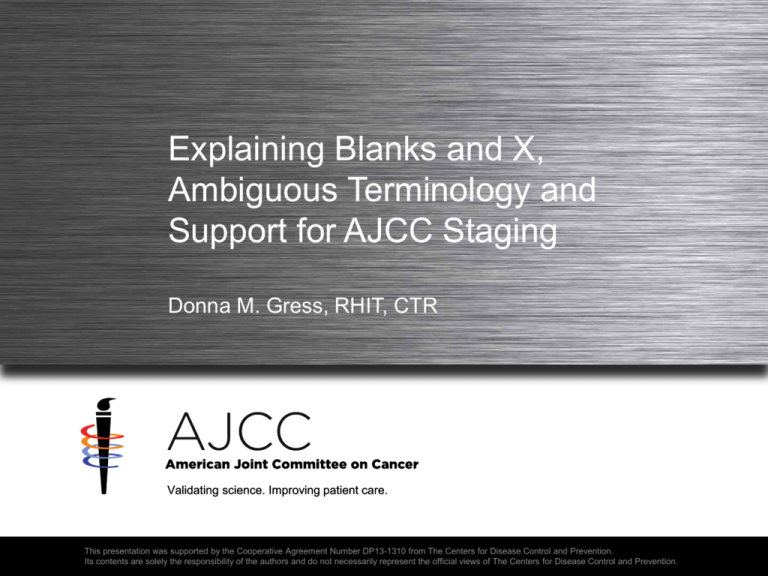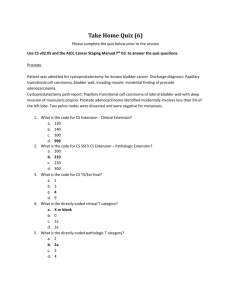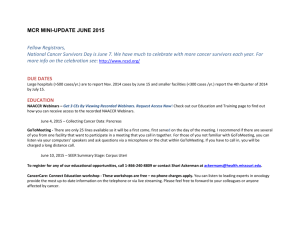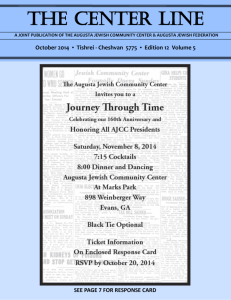
Explaining Blanks and X,
Ambiguous Terminology and
Support for AJCC Staging
Donna M. Gress, RHIT, CTR
Validating science. Improving patient care.
This presentation was supported by the Cooperative Agreement Number DP13-1310 from The Centers for Disease Control and Prevention.
Its contents are solely the responsibility of the authors and do not necessarily represent the official views of The Centers for Disease Control and Prevention.
Overview
• Provide guidance to cancer registrars on key topics
– Blank vs. X in registry data fields
– Ambiguous terminology
– Stage classification to use based on treatment provided
– Guidelines from other sources
– Information and questions on AJCC staging
2
Copyright © 2014 AJCC All Rights Reserved
Learning Objectives
• Recognize difference in definitions of blank and X
• Demonstrate correct usage of blank and X
• Employ critical thinking to terminology used
• Analyze physician terminology intent by multiple methods
• Determine stage classifications to apply by treatment choice
• Utilize appropriate guidelines
• Identify resources for AJCC staging
3
Copyright © 2014 AJCC All Rights Reserved
Registry Data Fields –
Blank vs. X
Completing Registry Data Fields
• Registry data fields seen on software screen
– CLINICAL
T
N
M
Stage Group
– PATHOLOGIC
T
N
M
Stage Group
• Use appropriate c or p data fields
– Based on what is needed to assign stage correctly
– Follows AJCC staging rules
• Do NOT use just elements in that one line
• Match stage assigned by physician
– According to AJCC rules
5
Copyright © 2014 AJCC All Rights Reserved
Blank vs. X
• AJCC defines X for T and N categories
– Cannot be assessed
• Cannot use X for other situations
– No surgical resection is NOT pTX pNX pM blank Stage 99
• Blank should be used when
– No information is available in chart
– Cannot be assigned a valid AJCC value
– Patient not eligible for pathologic stage
6
Copyright © 2014 AJCC All Rights Reserved
Registry Data Fields - Examples
• Patient had bowel obstruction and went directly to
surgery where colon cancer was found
• Physician assigned pathologic stage
– pT4a pN2a cM0 Stage IIIC
• cT blank cN blank cM0
Stage group blank or 99
• pT4a
pN2a
pM blank Stage group 3C
• Cannot assign clinical stage, cancer not known prior to
definitive treatment
– AJCC is stage group blank, but CoC requires non-blank value
for clinical stage
• pM is blank because appropriate M is cM0
7
Copyright © 2014 AJCC All Rights Reserved
Registry Data Fields - Examples
• Patient had CT chest with LLL tumor and mediastinal
nodes, mediastinotomy removed 4 nodes confirming N3
disease, concurrent chemoradiation will be given
• Physician assigned clinical stage
– T2a N3 M0 Stage IIIB (implied c, same as cT2a cN3 cM0)
• cT2a
cN3
cM0
Stage group 3B
• pT blank pN blank pM blank Stage group blank
• Biopsy of nodes is part of staging workup, cN
• Cannot assign pathologic stage, no resection of primary
– Not stage 99, implies criteria met but information unknown
8
Copyright © 2014 AJCC All Rights Reserved
Registry Data Fields - Examples
• Clinical stage of insitu cancer of breast, with total
mastectomy and no nodal resection
• cT blank cN0 cM0 Stage group 0
• pTis pN blank pM blank Stage group 0
• Can assign clinical and pathologic stage
– Rules state in situ assigned pTis cN0 cM0 for clinical and
pathologic
• pTis for clinical stage means cT is left blank
– Rules state both clinical and pathologic stage 0
– Rule put in place because nodes are usually not resected for
in situ cancers
– Meets breast criteria for pathologic classification
9
Copyright © 2014 AJCC All Rights Reserved
Registry Data Fields - Examples
• Clinical stage of insitu cancer of bladder with TURB
and no cystectomy
• cT blank cN0 cM0 Stage group 0
• pTis pN blank pM blank Stage group blank
• Cannot assign pathologic stage
– Bladder criteria of cystectomy has not been met
– Common to not find invasive tumor on TURB
– Do not use stage group 99, pathologic stage criteria not met
• 99 implies criteria met but information unknown
– Rules state that in situ assigned pTis cN0 cM0
10
Copyright © 2014 AJCC All Rights Reserved
Registry Data Fields - Examples
• Diagnostic workup includes biopsy of bone showing
mets from breast ca, no breast resection
• cT1 cN1 cM blank Stage Group 4
• pTblank pNblank pM1 Stage Group 4
• pM1 for clinical stage, biopsy was during workup
• pM1 is both clinical and pathologic stage IV according
to AJCC rules
– Case with pM1 may be grouped as clinical and pathologic
stage IV regardless of c or p status of T and N
11
Copyright © 2014 AJCC All Rights Reserved
CoC FORDS Values – Blank, X, 88, 99
• T, N, and M data fields
– Values allowed by FORDS
– Further explanations from AJCC
– Blank indicates
• No information in medical record
• Do not know if any assessment was performed
• Criteria not met for this stage classification so each category
(T,N,M) is blank
– X indicates not assessed
•
•
•
•
T cannot be assessed
N cannot be assessed
Does not apply to M, if patient was examined it can be assigned
Criteria met for this stage classification so each category is valid
value or X
– 88 indicates not applicable, not defined by AJCC
12
Copyright © 2014 AJCC All Rights Reserved
CoC FORDS Values – Blank, X, 88, 99
• Stage group data fields
– Values allowed by FORDS
– Further explanations from AJCC
– Blank indicates
• No information in medical record or
• Criteria not met for pathologic staging
– CoC does not allow blank for clinical staging
– 99 indicates unknown, not defined by AJCC
• 99 indicates T or N are unknown, and stage cannot be assigned
• 99 indicates T, N, or M are not specific enough to assign stage
– Example: T2 assigned when T2a or T2b needed to assign stage
• CoC mandates non-blank for clinical stage group, use 99
• Do not use 99 if pathologic staging criteria not met, use blank
– 88 indicates not applicable, not defined by AJCC
13
Copyright © 2014 AJCC All Rights Reserved
Key Points for Blank & X
Does patient meet criteria for that stage classification?
• Yes – patient meets classification criteria
– If physician could not assess T and/or N for the patient, and
– Definitive information for T and N not in chart
– Use TX and/or NX
• Yes – patient meets classification criteria
– No information about diagnostic workup or resection pathology
in chart
– Do not use X
• Implies physician did not assess or have info on patient’s T and/or N
– Use blank
• Indicates registrar could not find information in chart
14
Copyright © 2014 AJCC All Rights Reserved
Key Points for Blank & X
Does patient meet criteria for that stage classification?
• No – patient does NOT meet classification criteria
– Do NOT use X
• Indicates patient eligible for staging
• Implies physician did not assess or have info on patient’s T and/or N
– Must use blanks
• Indicates patient did not meet classification criteria
15
Copyright © 2014 AJCC All Rights Reserved
Key Points for Blank & X
• X can only be used according to AJCC definitions
• Must use blanks if AJCC criteria for X is not met
• Remember MX does NOT exist
• Assigning cM0 only requires patient to have had H&P
– Does not mean registrar must find H&P on chart
– If physician suspects mets
• It will be mentioned
• Treatment plan will be different
16
Copyright © 2014 AJCC All Rights Reserved
Ambiguous Terminology
Ambiguous Terminology
• AJCC does NOT
– Define ambiguous terminology
– Mandate how words should be interpreted
• How to interpret words for cancer involvement
– Review clinician’s statements
– Treatment choices may indicate clinician’s impression
– Review and analysis of entire case
•
•
•
•
•
•
•
Physical exam
Medical history of all other diseases
Symptoms
Imaging
Lab tests
Diagnostic procedures
All other available information
• Judgment call based on all aspects of patient’s care
18
Copyright © 2014 AJCC All Rights Reserved
Ambiguous Terminology Example
• Lung case
– CT chest reports mediastinal adenopathy
– Patient scheduled for LUL lobectomy
• Are the mediastinal nodes involved with cancer?
• Imaging analysis
– CXR are not sensitive and enlarged nodes may be involved
– CT, MRI, PET are very sensitive, could be infection,
inflammation, immune system reaction, or cancer
• Treatment analysis
– NCCN guidelines indicate surgery is not the primary therapy
for known involvement of mediastinal nodes (N2)
• Decision: mediastinal nodes are NOT involved
19
Copyright © 2014 AJCC All Rights Reserved
Ambiguous Terminology Example
• Duodenum case
– CT abd/pelvis reports duodenal tumor with extensive inflammation,
exudate and adherent to other loops of small bowel
– Patient scheduled for resection of tumor in duodenum
• Does adherence mean other bowel involved with cancer?
• Imaging and treatment analysis
– Exudate is fluid leaking from blood vessels due to inflammation
– Inflammation causing adherence, not tumor, if extensive
adherence they would not resect just local tumor and not do more
treatment, either more surgery or chemotherapy
• Decision: other small bowel are NOT involved
20
Copyright © 2014 AJCC All Rights Reserved
Stage Classification
Based on Treatment
Stage Classification Based on Treatment
• Surgical Treatment
– Clinical
– Pathologic
• Systemic and/or Radiation ONLY
– Clinical
• Neoadjuvant Therapy
– Clinical
– yclinical (after systemic/radiation but before surgery)
– ypathologic (after systemic/radiation AND surgery)
– Can NEVER do pathologic after neoadjuvant therapy
– Registrars do not have data field to record yc
22
Copyright © 2014 AJCC All Rights Reserved
Guidelines from Other Sources
CS Rules NOT Used for AJCC
• CS rules do not apply to AJCC
– Underlying principles are similar
– Detailed rules are not the same
24
Copyright © 2014 AJCC All Rights Reserved
CS Rules NOT Used for AJCC
• CS rules do not apply to AJCC
– AJCC Clinical and pathologic based on
• Different points in time
• Specific criteria
– Not exactly same as CS eval codes
25
Copyright © 2014 AJCC All Rights Reserved
CS Rules NOT Used for AJCC
• Rootstock – this is foundation or base of a plant
• Graft – plant that you want to grow
– It would not grow or survive on its own
– This plant needs a strong foundation or base
– It is grafted onto a rootstock which provides strong foundation
• Example on next slide is
– Left - Jacaranda tree = AJCC
• Tree is all AJCC, rootstock and entire plant, no grafts
– Right - Royal Poinciana = Collaborative Stage
• Tree is EOD & Summary Stage grafted onto AJCC rootstock
• Trees are very different – they are not the same
26
Copyright © 2014 AJCC All Rights Reserved
AJCC and CS Are Not The Same
AJCC is
the rootstock
and entire tree
27
Copyright © 2014 AJCC All Rights Reserved
CS is EOD & Summary
Stage grafted onto the
AJCC rootstock
Other Sources Not Used for AJCC Staging
• Guidelines from other sources cannot be used for
assigning AJCC stage
• Other sources not used for assigning AJCC stage
– MPH
– CS
– FORDS (only use allowable codes, do not use ambiguous
terms or any rules for assigning AJCC TNM)
– SEER Program Coding Manual
– Any manual that is not
• AJCC 7th edition Cancer Staging Manual or Handbook
• AJCC 2nd edition Cancer Staging Atlas
• Rules are valid only for publication to which they belong
28
Copyright © 2014 AJCC All Rights Reserved
Information and Questions
on AJCC Staging
AJCC Web site
• https://cancerstaging.org
• Cancer Staging Education menu includes
– Articles
• 18 articles on AJCC staging in various medical journals
– Resources
• Staging Moments – 15 case-based presentations in cancer
conference format to promote accurate staging with answers
and rationales
– Webinars
• 14 free webinars on staging rules and some disease sites
• Watch for education plans and content in the future
30
Copyright © 2014 AJCC All Rights Reserved
AJCC Cancer Staging Manual and Atlas
Order at
http://cancerstaging.net
31
Copyright © 2014 AJCC All Rights Reserved
CAnswer Forum
• Submit questions to AJCC Forum
– Located within CAnswer Forum
– Provides information for all
– Allows tracking for educational purposes
• http://cancerbulletin.facs.org/forums/
32
Copyright © 2014 AJCC All Rights Reserved
Summary
Summary
• Discriminate between blank and X usage
– Assign X according to AJCC rules
• Apply critical thinking when interpreting physician’s words
– Do not use registry ambiguous terminology lists
– Take into account available information
• Recognize appropriate stage classifications for each case
– Treatment choices will identify eligible stage options
• Differentiate guidelines available for registrars
• Identify resources
– Information and guidance
– Obtain answers to questions
34
Copyright © 2014 AJCC All Rights Reserved
Thank you
Donna M. Gress, RHIT, CTR
AJCC Technical Specialist
633 N. Saint Clair, Chicago, IL 6011-3211
cancerstaging.org
No materials in this presentation may be repurposed without the express written permission of the
American Joint Committee on Cancer. Permission requests may be submitted at CancerStaging.net









